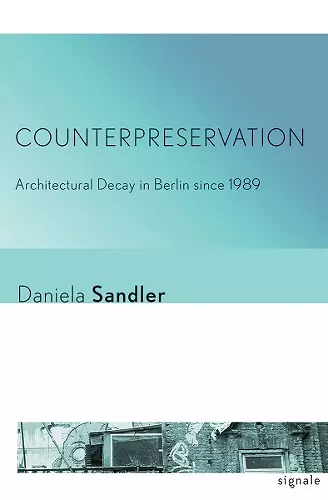Counterpreservation
Architectural Decay in Berlin Since 1989
Format:Hardback
Publisher:Cornell University Press
Published:15th Dec '16
Currently unavailable, and unfortunately no date known when it will be back
This hardback is available in another edition too:
- Paperback£23.99was £23.99(9781501703171)

In Berlin, decrepit structures do not always denote urban blight. Decayed buildings are incorporated into everyday life as residences, exhibition spaces, shops, offices, and as leisure space. As nodes of public dialogue, they serve as platforms for dissenting views about the future and past of Berlin. In this book, Daniela Sandler introduces the concept of counterpreservation as a way to understand this intentional appropriation of decrepitude. The embrace of decay is a sign of Berlin's iconoclastic rebelliousness, but it has also been incorporated into the mainstream economy of tourism and development as part of the city's countercultural cachet. Sandler presents the possibilities and shortcomings of counterpreservation as a dynamic force in Berlin and as a potential concept for other cities.
Counterpreservation is part of Berlin's fabric: in the city's famed Hausprojekte (living projects) such as the Køpi, Tuntenhaus, and KA 86; in cultural centers such as the Haus Schwarzenberg, the Schokoladen, and the legendary, now defunct Tacheles; in memorials and museums; and even in commerce and residences. The appropriation of ruins is a way of carving out affordable spaces for housing, work, and cultural activities. It is also a visual statement against gentrification, and a complex representation of history, with the marks of different periods—the nineteenth century, World War II, postwar division, unification—on display for all to see. Counterpreservation exemplifies an everyday urbanism in which citizens shape private and public spaces with their own hands, but it also influences more formal designs, such as the Topography of Terror, the Berlin Wall Memorial, and Daniel Libeskind's unbuilt redevelopment proposal for a site peppered with ruins of Nazi barracks. By featuring these examples, Sandler questions conventional notions of architectural authorship and points toward the value of participatory environments.
Sandler concludes with a brilliantly argued case for the worldwide significance of counterpreservation as a conceptual force that challenges the fundamental tenets of historic preservation as it is practiced in the West today.
(Choice)Sandler imagines how architecture might grapple with the concept of transience, creating buildings that show the futility of hanging on to the past.... Any good contemporary reading of Berlin must come to grips with the city's relationship to its own decay. Sandler's accessible, smart book deserves a place on the reading list for the thoughtful kind of Berlin tourist, for student study abroad groups, and for those writing about the many rises and falls that have happened in the capital city of what has come to be known as 'The Berlin Republic.'
(The German Quarterly)Sandler sees a categorical difference between counterpreservation and the fascination with ruins and ancient monuments inherent in some traditional conservationist approaches.... In general Sandler's book stands out for her perspicacious perspective, which is also related to the fact that she looks at the city from the perspective of an outsider.... A must-read for any student or scholar interested in Berlin's history and the fascinating ways in which the past manifests in the city's urban fabric.
(Planning Perspectives)Daniela Sandler presents rugged methods of stewardship and alteration of Berlin buildings that constitute a 'reflective nostalgia' instead of a 'restorative nostalgia,' revealing preservation as a productive practice with its own embedded political and cultural editorial power.... May spur the field to reconsider that very basic mode of always interrogating, sometimes appreciating, and often conserving heritage artifacts as we find them—which has long been called simply preservation.
(buildings & landsca- Winner of Antoinette Forrester Downing Award 2018 (United States)
ISBN: 9781501703164
Dimensions: 229mm x 152mm x 25mm
Weight: 907g
274 pages